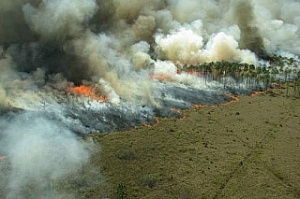Artyom Lim and Daria Kuzmina, two young TSU scientists who are staff members of the Bio-Geo-Clim laboratory, worked for two months at one of the leading scientific centers in France - the Midi-Pyrenees Observatory. In the interdisciplinary laboratory GET (Geosciences Environnement Toulouse), young researchers analyzed water samples from Siberian rivers and samples of marsh and north-taiga vegetation from the Arctic zone of Russia. The results will help in understanding the processes of the transport of carbon, one of the main components of greenhouse gases.
In the last decade, catastrophic fires have occurred more and more often. Climate warming is one of the reasons for the increase in the number of fires. Tragic examples are the events in Australia in 2019-2020, and in Russia’s Far East and Siberia in recent years, plus in the European part in 2012.
- The instant release of mineral nutrients from burned vegetation and plant litter can change the geochemical and biological environment, says Daria Kuzmina, a postgraduate student at the TSU Biological Institute. - To assess such changes, it is necessary to know the rate and characteristics of the reactions of plant ash and natural waters, such as rainfall, river and lake water, and subsurface runoff. Only after conducting such studies will we be able to obtain enough information to extrapolate the results to the basins within which the burned vegetation was selected.
The effect of the release of mineral nutrients after fires in arctic and subarctic conditions is becoming especially interesting, says Daria Kuzmina. - In low-productive northern ecosystems, the mobilization of chemical elements leads to severe losses of valuable elements of mineral nutrition of plants. Preliminary studies have shown that the leaching of elements occurs very quickly, and this can make significant adjustments to the biogeochemical situation, for example, lead to a short-term increase in the productivity of draining water bodies. Experiments are planned for next year to provide a detailed description of the consequences of fires.
It has been established that half of the carbon is supplied to lakes and rivers from burned catchments in the 5-10 years after the fire. As a result, less carbon dioxide is emitted from rivers. It turns out that a fire instantly emits a lot of carbon dioxide, but in the next decades, its entry into the atmosphere decreases sharply, and the postpyrogenic ecosystem, on the contrary, begins to actively absorb and accumulate lost carbon due to the growth of new biomass, microorganisms.
- It is important to note that the northern ecosystems, in general, are very pyrophilous and degrade without fire, - adds Daria Kuzmina. - After a fire, boreal-tundra ecosystems seem to start a new cycle of carbon accumulation.
For the experiment with leaching elements from ash in the GET laboratory, TSU staff took samples of bog northern taiga vegetation while working at the TSU scientific base in Khanymei. Extraction with lake water was made from burned samples of peat, moss, and lichens, followed by interval collection of samples for analysis. The main goal was to find out how the geochemical situation in the postfire ecosystem changes, and how these changes affect the geochemistry of soil and river runoff into the world’s oceans.

